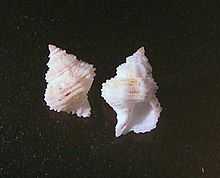Coralliophilinae
| Coralliophilinae | |
|---|---|
 | |
| Two shells of Mipus crebrilamellosus | |
| Scientific classification | |
| Kingdom: | Animalia |
| Phylum: | Mollusca |
| Class: | Gastropoda |
| (unranked): | clade Caenogastropoda clade Hypsogastropoda clade Neogastropoda |
| Superfamily: | Muricoidea |
| Family: | Muricidae |
| Subfamily: | Coralliophilinae Chenu, 1858 |
| Genera | |
|
See text | |
| Synonyms | |
| |
Coralliophilinae is a taxonomic group, a subfamily of about 200–250 sea snails, marine gastropod mollusks commonly known as the coral snails or coral shells. This is a subfamily within the very large family Muricidae, the murex or rock snails.
According to the taxonomy of the Gastropoda (Bouchet & Rocroi, 2005), this group is considered to be a subfamily, the Coralliophilinae, of the family Muricidae.[1] Prior to the taxonomy of the Gastropoda (Bouchet & Rocroi, 2005), the Coralliophilinae was recognized as a distinct family the Coralliophilidae. The subfamily Coralliophilinae is monophyletic, as confirmed by genetic research with molecular markers.[2]
Distribution and habitat
The coral snails are coral dwellers that occur worldwide in temperate and tropical seas. They can be found in very diverse places such as the mid-Atlantic seamounts, the Canary Islands, the deep water coral banks in the Mediterranean, from the Florida Keys to Brazil, the Indo-Pacific Region, the southwest Pacific, the Austral Islands (South Pacific). Such a dispersal of the subfamily can be attributed to oceanic currents and planktotrophic larval development. [3]
These snails are specialist feeders, feeding exclusively on anthozoans by boring into them. A few live between soft corals and anemones and use their long and extensible proboscis to ingest the soft tissue. Some feed on sea fans.
Genera
Genera within the subfamily Coralliophilinae include:[4]
- Babelomurex Coen, 1922
- Coralliophila H. Adams & A. Adams, 1853
- Emozamia Iredale, 1929
- Hirtomurex Coen, 1922
- Latiaxis Swainson, 1840
- Leptoconchus Rüppell, 1834
- Liniaxis Laseron, 1955
- Magilus Montfort, 1810
- Mipus de Gregorio, 1885[5]
- Rapa Röding, 1798
- Rhizochilus Steenstrup, 1850
- Genera brought into synonymy
- Aradasia Settepassi, 1970 = synonym of Coralliophila H. Adams & A. Adams, 1853
- Aradomurex Coen, 1947 = synonym of Coralliophila H. Adams & A. Adams, 1853
- Coralliobia H. Adams & A. Adams, 1853 = synonym of Coralliophila H. Adams & A. Adams, 1853
- Echinolatiaxis Kosuge, 1979 = synonym of Babelomurex Coen, 1922
- Fusomurex Coen, 1922 = synonym of Coralliophila H. Adams & A. Adams, 1853
- Laevilatiaxis Kosuge, 1979 = synonym of Babelomurex Coen, 1922
- Lamellatiaxis Habe & Kosuge, 1970 = synonym of Babelomurex Coen, 1922
- Langfordia Dall, 1924 = synonym of Babelomurex Coen, 1922
- Latimurex : synonym of Latiromurex Coen, 1922
- Latiromurex Coen, 1922 = synonym of Coralliophila H. Adams & A. Adams, 1853
- Lepadomurex Coen, 1922 = synonym of Coralliophila H. Adams & A. Adams, 1853
- Magilopsis G.B. Sowerby III, 1919 = synonym of Leptoconchus Rüppell, 1834
- Pseudomurex Monterosato, 1872 = synonym of Coralliophila H. Adams & A. Adams, 1853
- Quoyula Iredale, 1912 = synonym of Coralliophila H. Adams & A. Adams, 1853
- Rapella Swainson, 1840 = synonym of Rapa Röding, 1798
- Reliquiaecava Massin, 1987 = synonym of Coralliophila H. Adams & A. Adams, 1853
- Rhombothais Woolacott, 1954 = synonym of Coralliophila H. Adams & A. Adams, 1853
- Tarantellaxis Habe, 1970 = synonym of Babelomurex Coen, 1922
- Tolema Iredale, 1929 = synonym of Babelomurex Coen, 1922
Within this subfamily, the systematics at species level is problematic as many adult species show broad intraspecific morphologic variability that also depends on the substrate they live. The morphology of the protoconch is usually very helpful as a taxonomic character.
References
- ↑ Bouchet P. & Rocroi J.-P. (Ed.); Frýda J., Hausdorf B., Ponder W., Valdés Á. & Warén A. 2005. Classification and nomenclator of gastropod families. Malacologia: International Journal of Malacology, 47(1-2). ConchBooks: Hackenheim, Germany. ISBN 3-925919-72-4. Issn = 0076-2997. 397 pp. http://www.vliz.be/Vmdcdata/imis2/ref.php?refid=78278
- ↑ Barco, A.; M. Claremontb, c, D.G. Reidb, R. Houartd, P. Bouchete, S.T. Williamsb, C. Cruaudf, A. Coulouxf and M. Oliverio (September 2010). "A molecular phylogenetic framework for the Muricidae, a diverse family of carnivorous gastropods". Molecular Phylogenetics and Evolution 56 (3): 1025–1039. doi:10.1016/j.ympev.2010.03.008. PMID 20226866. Retrieved 2010-08-18.
- ↑ Oliverio, Marco; Gofas, Serge, Coralliophiline diversity at mid-Atlantic seamounts (Neogastropoda, Muricidae, Coralliophilinae) , Bulletin of Marine Science, Volume 79, Number 1, July 2006 , pp. 205-230(26)
- ↑ WoRMS : Coralliophilinae; accessed on 2 February 2011
- ↑ Gofas, S. (2010). Mipus de Gregorio, 1885. In: Bouchet, P.; Gofas, S.; Rosenberg, G. (2010) World Marine Mollusca database. Accessed through: World Register of Marine Species at http://www.marinespecies.eu/aphia.php?p=taxdetails&id=205148 on 2010-08-01
- Vaught, K.C. (1989). A classification of the living Mollusca. American Malacologists: Melbourne, FL (USA). ISBN 0-915826-22-4. XII, 195 pp